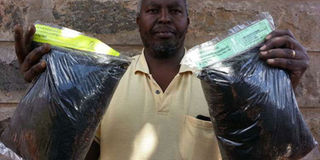Give me cane waste, and I’ll make you organic fertiliser

Mr Job Mwangi displays packs of 'Joka Biochar 50/50 fertilizer that he makes from sugarcane bagasse. PHOTO | BONIFACE MWANGI
What you need to know:
- The farmer has been in the business of extracting sugarcane juice in Nyeri Town for the last two years but it is only recently that he diversified into fertiliser.
- The secondary school agriculture teacher says about 50 per cent of the fertiliser is active carbon while the rest is manure or any other organic material that helps crops to grow.
- Martin Wachira, who recently bought several bags of Mwangi’s fertiliser to grow capsicum on one acre in Lamuria, says from the way his crops are flourishing, the fertiliser is good.
The structure made of polythene cover and wooden poles on Job Mwangi’s farm in Nyeri appears like a flourishing greenhouse.
However, a peep inside tells a different story. Spread inside is what looks like dry sisal.
But this is cane waste, otherwise known as bagasse. Mwangi uses it to make fertiliser.
I find Mwangi and his son Patrick Mugambi spreading the waste in the greenhouse for drying before using it to make the input that he has branded Joka Biochar 50/50 fertiliser.
The farmer has been in the business of extracting sugarcane juice in Nyeri Town for the last two years but it is only recently that he diversified into fertiliser.
“I used to throw away the waste after squeezing juice out of canes. But a research on how to use it led me into making the product that enhances nutrients in the soil,” recalls the agriculture teacher who started the project about four months ago.
To make the fertiliser, Mwangi ensures the bagasse is completely dry.
RIGHT MIX
“I later carbonise it; burning the bagasse at about 1,000 degree Celsius. However, despite the high temperature, the carboniser prevents the waste from burning completely. This process is known as pyrolysis and it involves heating biomass in a low oxygen environment,” says Mwangi, who uses a metallic tank to carbonise the bagasse and make up to 15 40kg bags of the fertiliser every day.
The secondary school agriculture teacher says about 50 per cent of the fertiliser is active carbon while the rest is manure or any other organic material that helps crops to grow.

Mr Mwangi spreads the bagasse in his greenhouse so that they can dry up properly before carbonizing. PHOTO | BONIFACE MWANGI
“Active carbon gives the soil the ability to absorb acid and to increase its water retention capacity by up to six times,” he says.
After pyrolysing, he adds water – in a process known as quenching – to the black substance inside the carboniser to increase its ability to retain water and host more micro-organisms. He, thereafter, adds to the biochar (carbonised waste) well-composed manure from sheep or poultry in a ratio of 2:3.
“We add manure to increase its ability to hold water as well as micro-organisms that are needed for growth of crops,” says the teacher.
The mixture is then left to dry for three to four days before it is put into a mill to thoroughly break and mix it.
“At this point I add some water to the mixture and pack it in perforated polythene bags. This is to increase aeration and after three days, I pack it in the normal bags,” explains Mwangi, who operates on quarter-acre in Transformer Estate, and pumped into the project over Sh200,000.
He says two-and-a-half kilos of his biochar fertiliser is enough to grow crops in a 100ft square piece of land.
In a month, he sells more than 30 40kg bags, which go for Sh1,500 each. He also packs his produce in smaller packages of 2.5kg that go for Sh150.
“I am currently in the process of certifying the product with the Kenya Bureau of Standards. Once I am done with it, I’ll expand my business and employ people,” says the 53-year-old.
He buys a seven-and-half feet cane at Sh30 from farmers in Nyeri after sampling to determine the sucrose content using a refractometer.
“The sucrose content must be 13-15 per cent. Such canes have a lot of potassium, calcium, iron and manganese in them, which is good for crops.”
Martin Wachira, who recently bought several bags of Mwangi’s fertiliser to grow capsicum on one acre in Lamuria, says from the way his crops are flourishing, the fertiliser is good.
The fertiliser is applied directly during planting time and can also be applied on long-term crops like coffee, bananas, fruits and tea.
SOIL MOISTURE
“Put one tablespoon of biochar in every hole during planting and mix it with soil. The fertiliser has several benefits among them it buffers soil PH and eliminates acidity, promotes water retention and prevents leaching of nutrients such as nitrate (NO3-), ammonium (NH4+) and phosphate (PO43-).”
According to research, biochar increases crop yields, particularly if the soil is poor. It further helps to prevent fertiliser runoff and leeching, allows the use of less fertiliser and protects the environment.
The fertiliser is also useful in retaining soil moisture and it replenishes exhausted or marginal soils with organic carbon and fosters the growth of soil microbes.
“From the tests that I have carried out, this product absorbs toxins from soils especially agro-chemical residues and holds carbon,” says Mwangi, who also grows tree tomato and maize.
John Wambugu, an agronomist from the Ministry of Agriculture, Nyeri, says the product is efficient only if the manufacturer doesn’t squeeze all the sucrose from the cane.
“When all the sugar content is extracted from the cane, the resultant ‘fertiliser’ will only be good for mulching. One should watch against that.”




